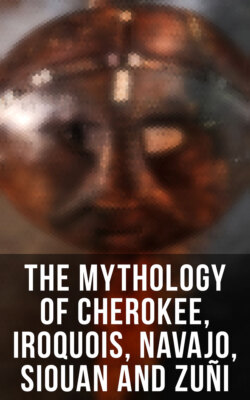Читать книгу The Mythology of Cherokee, Iroquois, Navajo, Siouan and Zuñi - James Mooney - Страница 31
На сайте Литреса книга снята с продажи.
The 'Nations' of North America
ОглавлениеIn order that the reader may be enabled the better to comprehend the history and customs of the Red Race in North America, it will be well at this juncture to classify the various ethnic stocks of which it is composed. Proceeding to do so on a linguistic basis—the only possible guide in this instance—we find that students of American languages, despite the diversity of tongues exhibited in North America, have referred all of these to ten or a dozen primitive stems.8 Let us first examine the geographical position of the 'nations' of the American aborigines in the sixteenth century, at the period of the advent of the white man, whilst yet they occupied their ancestral territory.
The Athapascan stock extended in a broad band across the continent from the Pacific to Hudson Bay, and almost to the Great Lakes below. Tribes cognate to it wandered far north to the mouth of the Mackenzie River, and, southward, skirted the Rockies and the coast of Oregon south of the estuary of the Columbia River, and spreading over the plains of New Mexico, as Apaches, Navahos, and Lipans, extended almost to the tropics. The Athapascan is the most widely distributed of all the Indian linguistic stocks of North America, and covered a territory of more than forty degrees of latitude and seventy-five degrees of longitude. Its northern division was known as the Tinneh or Déné, and consisted of three groups—eastern, north-western, and south-western, dwelling near the Rockies, in the interior of Alaska, and in the mountain fastnesses of British America respectively.
The Pacific division occupied many villages in a strip of territory about four hundred miles in length from Oregon to Eel River in California. The southern division occupied a large part of Arizona and New Mexico, the southern portion of Utah and Colorado, the western borders of Kansas, and the northern part of Mexico to lat. 25°. The social conditions and customs as well as the various dialects spoken by the several branches and offshoots of this great family differed considerably according to climate and environment. Extremely adaptable, the Athapascan stock appear to have adopted many of the customs and ceremonies of such tribes as they were brought into contact with, and do not seem to have had any impetus to frame a culture of their own. Their tribes had little cohesion, and were subdivided into family groups or loose bands, which recognized a sort of patriarchal government and descent. Their food-supply was for the most part precarious, as it consisted almost entirely of the proceeds of hunting expeditions, and the desperate and never-ending search for provender rendered this people somewhat narrow and material in outlook.
